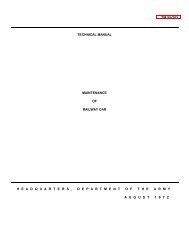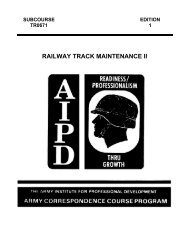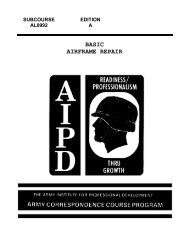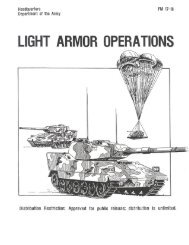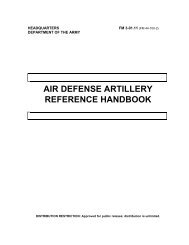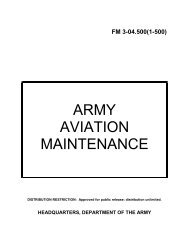fm 44-100 us army air and missile defense operations
fm 44-100 us army air and missile defense operations
fm 44-100 us army air and missile defense operations
Create successful ePaper yourself
Turn your PDF publications into a flip-book with our unique Google optimized e-Paper software.
Cruise <strong>missile</strong>s<br />
• Location of surveyed launch sites?<br />
FM <strong>44</strong>-<strong>100</strong><br />
A-31. Capabilities of threat cruise <strong>missile</strong>s:<br />
• Performances (duration of flight, speed, altitude, <strong>and</strong> launch<br />
restrictions)?<br />
• Maximum <strong>and</strong> minimum ranges?<br />
• Circular error probable?<br />
• Targeting capabilities <strong>and</strong> type?<br />
• Contour flying capability?<br />
• Vulnerability to countermeasures?<br />
• Guidance modes?<br />
• Warhead type <strong>and</strong> size?<br />
CONDUCT TARGET VALUE EVALUATION<br />
A-32. This should determine what targets are to be labeled as high-value<br />
targets. High-value targets are assets the enemy or friendly comm<strong>and</strong>er has<br />
deemed as important for the successful accomplishment of his mission. Highvalue<br />
targets are determined by operational necessity <strong>and</strong> weapon system<br />
capability.<br />
DETERMINE THREAT COURSES OF ACTION<br />
A-33. Determining both the enemy <strong>air</strong> <strong>and</strong> ground courses of action<br />
integrates the results of the previo<strong>us</strong> three steps into a meaningful<br />
concl<strong>us</strong>ion. Given what enemy <strong>air</strong> <strong>and</strong> <strong>missile</strong> forces prefer to do, <strong>and</strong> the<br />
effects of the operational environment, what are the enemy's likely objectives<br />
<strong>and</strong> what COA is available to him? The G2 or S2 develops threat models that<br />
depict the enemy's <strong>air</strong> <strong>and</strong> <strong>missile</strong> COA. They also prepare event templates<br />
<strong>and</strong> matrices that foc<strong>us</strong> intelligence collection on identifying which COA the<br />
enemy will execute. The process of developing these templates <strong>and</strong> matrices<br />
is covered in depth in FM 34-130. The decision support template is an<br />
integrated staff product that results from the war gaming of potential<br />
friendly courses of action.<br />
SITUATION TEMPLATE<br />
A-34. A situation template is a graphic depiction of expected enemy<br />
dispositions should they adopt a particular COA. They <strong>us</strong>ually depict the<br />
most critical point in the operation as agreed upon by the G2 <strong>and</strong> G3.<br />
However, the G2 or S2 might prepare several templates representing<br />
different snapshots in time starting with the initial threat array. The<br />
situation template integrates <strong>air</strong> attack <strong>and</strong> surveillance profiles with<br />
terrain. It foc<strong>us</strong>es on specific <strong>air</strong> avenues of approach <strong>and</strong> mobility corridors<br />
to determine which avenues are the most capable of supporting specific<br />
attack techniques, profiles, <strong>and</strong> the most direct routes to l<strong>and</strong>ing <strong>and</strong> drop<br />
zones to protect <strong>and</strong> ensure the survivability of <strong>air</strong> threat systems. See FM<br />
34-130 for detailed information on preparing a situation template.<br />
A-9




